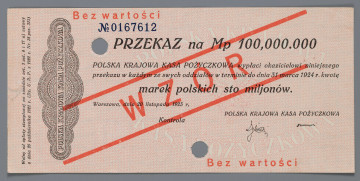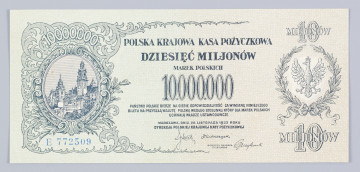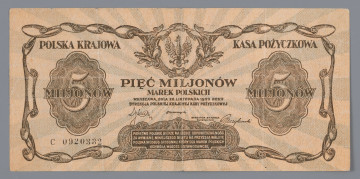
Cheque for 100,000,000 Polish marks - a template
1923
National Museum in Lublin
Part of the collection: Paper money during the Second Polish Republic
The inflation of the Polish mark (mkp), progressing since 1919, began to gain momentum, leading to its deep devaluation in 1921. The source of this phenomenon was the post-war economic crisis of the European countries involved in the conflict, especially the defeated Germany, whose currency was linked to the mkp. Germany's need to repay war reparations, a negative trade balance, and a growing budget deficit, compensated for by the printing of banknotes with no real cover in gold - these were the most important causes of the German mark's depreciation. The economic condition of the reborn Poland was determined at the outset by the country's devastation, which resulted from warfare and the partitioners' exploitation of our lands. A pressing challenge was to integrate the territories that had hitherto functioned within the legal, economic and social structures of foreign states, and to build a central fiscal and tax apparatus for the reborn state.
Rising expenditure, coupled with insufficient tax revenue and an unfavourable trade balance, exacerbated the budget deficit. Attempting to balance it out, the issue of money was increased, which in turn deepened its depreciation and necessitated the introduction into circulation of ever higher inflationary denominations. This trend was strongly marked in 1922 with the introduction of 10,000 mkp and then 50,000 mkp on 25 January 1923.
The devaluation of the mkp is illustrated by its relation to the dollar. At the end of September 1922 almost 8870 mkp had to be paid for it, at the end of 1922 17 800 mkp and three months later already 42 300 mkp. At that time, 50,000 mkp was slightly above the value of the US currency. Prices rose exponentially. Just one year before the introduction of the banknote in question, the evening issue of "Kurier Warszawski" increased in price from 20 to 200 mkp. At that time, this press offered to sell "a brand-new piano made by a well-known Petersburg factory, a short concert grand, 7 1/2 octaves, of an exceptionally fine construction, with a beautiful tone" for the bargain price of mkp 6,500,000, as well as offering a 200,000 reward for finding a lost large Siberian dog and a 50,000 mkp reward for returning a found bone earring, "valuable as a keepsake".
The inflationary series of banknotes initiated with the denomination of 10,000 mkp was designed by artists of the State Graphic Works in Warsaw.
Tomasz Markiewicz
Author / creator
Dimensions
cały obiekt: height: 206 mm, width: 104 mm
Object type
paper money
Technique
Material
paper
Creation time / dating
Creation / finding place
Owner
The National Museum in Lublin
Identification number
Location / status

1923
National Museum in Lublin

1923
National Museum in Lublin

1923
National Museum in Lublin
DISCOVER this TOPIC
Museum of King Jan III's Palace at Wilanów
DISCOVER this PATH
Educational path